Uropi: Indeuropan migrade - Migrations indo-européennes - Indo-European migrations
★ ★ ★
* Uropi Nove 136 * Uropi Nove 136 * Uropi Nove 136 *
★ ★ ★
★ ★ ★
I) Kim usvizì Indeuropane ?
Fenden se de Nazi mita ov de blu-oji, blondikevili Arian: Indeuropane avì nevos sen blondi ki blu oje; lu avì nar kevile, bran oje id olivi-bran kut: di se wa dik no de DNA nemen od skelete finden in Kurgàne.
De Nazi mitas sì jok maj matim ankredli: lu dez te Indogermàne - wim lu nomì la - venì od Thule, u dali isel ner Nordipola. In mol veti teme, lu venì niz id civilizì prim Grece, pos Romane, id i zav ne verim kan lu se forseten avo civilizen Perse id Indiane. Johann Chapoutot, u historìst we studì Nazi mitologij dez: « De regìm ustelì bediko, ki de kost històri disvirgadis… te Grece id Romane venì od nord, sam ki Germàne ». A. Rosenberg, u Nazi teorìst dezì te « Grece sì u nordi polk », id Hitler som menì te je stì u « rasi unid » intra Grece, Romane id Germàne. Heinrich Himmler, we sì obseden ki da teorije avì inkargen de Ahnenerbe (‘Forgèni erdad’) findo arkeologic pruve ov la, wen, naturim, lu findì ne.
Idmàj de vord Arian som avì nit a deto ki Germàne. Di vord, aryā sinì ‘nobel’ id je vidì uzen pa Indiranine po nomo sia som. Aryāna, (de land) Arianis, od wo, in veti Persi Aryānam Xshathra, pos Ērānšahr ‘de rainia Arianis’, davì de vord Iràn.
Pos de wer, arkeologiste probì findo siensim de ‘veri’ odveni domaria Indeuropanis. Tal inizì in de jare 50, wan Marija Gimbutas, u jun Lituvi-Amerikan arkeologista, bazan sia obe su lingu id arkeologic datas, publizì in 1956, ci tez intitlen « De hipotèz kurganis » we sitì de odveni domaria in de Pontiki stepas be sud Rusiu id Ukrainiu, in wa ce nomì de Kurgàni kultùr. Kurgàne se grube plasen ude gren tume, we vidì usgraven; lu se mol semli a de nekropòl in Vergina (Makedonia) id a de « grub » Agamemnoni in Mikene. Slogan ca de polk Kurganis sì de Indeuropane. Obte ci findade vidì kritiken, ci tez vidì renemen pa André Martinet, de Franci linguìst, in de jare 80, in hi bib Od stepe a oseàne. Ba subetàl, lu vidì koveren id procizen be inìz de jare 2000, pa de Amerikan arkeologìst David W. Anthony, we, pos avo usgraven mole kurgàne, publizì hi bib The Horse the Wheel and language (Kwal, Rol id Linga) in 2007. Pos de fal USSRi kovarkad vidì mozli id lezi intra Amerikan id Europan arkeologiste id li Ukraini id Rusi kolege. Analizan de apreste finden in kurgane od sudi Ukrainia a nord Kaukazi, he bedikì te Indeuropane sì nomàdi pastore (ki herde ovinis, kadus, govis), we avì domizen id raiten kwale (tramìd altene, he studì de usuzad kwalidantis deben a gisel), wa davì lo u gren prodèl su de alten polkade; lu smitì os bronzi arme id avì inporten rol od Midostia tra Kaukàz (Maikopi kultùr).
★ ★ ★
Maria Gimbutas
★ ★ ★
Wan un vok ov Indeuropane, je del ne ov un uni kultùr, ba ov u subesetad kulturis spanan sur 2 tiljàre, od 4500 a 2500 for ni ev. De posni polke, daze we disspajì sur nordosti Europa id in de Dunavi val, inforsan za li linga se de Jamnayas (kultùr de grovigrubis, od Rusi jama = grov). Po Anthony id mole altene, Indeuropane koruvòk a de Jamnaja kultùr. Di sin ne naturim te de foritan kulture vokì ne prinizi forme Indeuropani.
Di arkeologic diskrovade vidì koveren, dod 2015 pro, pa de stude su DNA: Jamnajas av 3/4 DNA in komùn ki de veti polkade od Nordosti Europa (Korden Keramiki kultùr), id 40% a 54% ki de moderni Europane: di posuntad se minivan od ost a west id se priʒe miki in westi Midimari isle wim Korsia id Sicilia (7 a 10%). Di sin te Jamnajas disspajì su vasti teritorias nordi id midosti Europu wo lu intramicì ki polkade lokal cagoris-plikoris (wej DNA dik un eki posuntad blu-oji blondis). Sam lu formì de Korden Keramiki kultùr.
De DNA nemen od Jamnaja liente dik te lu avì dum kevile id oje id olivibràn kut. Begòn, DNA nemen od veti cagore-plikore in nordi Europa (de maj seni se daten 7700 jare) dik te veti Europane avì u bij kut, blu oje id blondi kevile, longim for Indeuropane migrì in Europa. De maj veti blondi mumij vidì finden in Rusia id sì daten 15000 jare.
Pos li migrad a nordi id ostimidi Europa, Indeuropane intramicì ki de lokal veti Nordeuropane id sam lu formì de Korden Keramiki liente.
Solem fori sedia i mozì kogono Indeuropane « in karn » id kose, is i moz voko sim. Un av ustelen, od Jamnaja krane finden in Kurgàne, restruo de kebe id fase eke Jamnaja manis. Wim un moz vizo in de vari fotòs daven zi, lu sì nè bijkuti, nè blu-oji, nè blondikevili; lu avì u fiziki usvìz wen un moz findo odia tal aròn Midimar, in Midostia, in Iràn id Nordindia. In un vord, veri Ariane.
II) Indeuropan migrade
A) Do ost > Afanasievo, Sintacta, Andronovo
Je stì du cevi Jamnaja migrade do ost; de pri sì purim Jamnaja id usvenì beròn 3500 for ni ev.
★ ★ ★
★ ★ ★
1) Afanasievo > Tokharine
De Afanasievo kultùr (beròn -3500 -2500) sì siten in sudi Sibiria in Altàj bore. Je se karakterizen pa ji grube in kurgàne we se mol semli a de Jamnaja kurgàne. Afanasievo liente sì mij-nomàdi pastore ki herde govis, ovinis, kadis id kwalis. De DNA finden in Afanasievo grube se bemarklim somi a daz de Jamnaja kulturi, wa det na kospeko te je sì u direkti migrad od de Pontiki-Kaspian stepas ane intramicad. Slogan James Mallory id Bernard Sergent de Afanasievo polke se versemim de forgène de Tokharinis we ʒivì in de basin Tarim (Xinjiang in Cinia) id vokì du neri Indeuropan lingas Arśi /Agni id Kuči, os nomen Tokhari A id B. Europan-tipi mumije,daten 1800 for ni ev, vidì os finden in de basin Tarim. Tekste in Tokhari vidì skriven su papìr ki de Brāhmī (un Indian) alfabèt id vidì discifren be inìz 20i suntjàri, wa dikì te lu sì andubim Indeuropan lingas.
2) Sintacta > Indiràni, Andronovo
De Sintacta kultùr (2100 -1800 for ni ev), siten in de stepa be sud Urali boris in Rusia, koruvòk a u duj voln migradi do ost ba, gonim a Afanasievo, je venì ne direktim od de Jamnaja kultùr, ba od de Korden Keramiki kultùr we sì ʒa u micad intra Jamnajas id veti Europane.
De Sintacta DNA se mol neri a daz de Korden Keramiki polkis (haplotipe R1a). De maj veti apreste duroli kambikaris in mold vidì finden in Sintacta grube; di kare disspanì tra tal de veti mold id jegì u priplani rola in de were Antikevis. De Sintacta kultùr se os karakterizen pa de metalivark kupri id arseniki bronzi.
Un men te Sintacta liente avì voken Proto-Indiràni, de forgèn de Indiràni lingu famili.
Od de Sintacta kultùr venì ap migrade do sud Indiraninis do Anatolia, Iràn id India. Dod de 9i suntjàr for ni ev, Iranivokan Skite migrì od Sintacta do west, ru a de Pontiki stepas.
★ ★ ★
Restruen kambikàr, muzea Arkaim
★ ★ ★
Andronovo 1800- 1300 fnE, Srubnaja
Proto-Iranine migrì niz od Sintacta, prim do ost, slogan Proto-Indariane (da se de forgène Indianis). Un find Proto-Indariane in de Andronovo kultùr (ustensan od de basin Volgu: Srubnaja kultùr tis Afanasievo kultùr in Sibira), trawàn Proto-Iranine, koruvòk a de Srubnaja kulrùr, maj do west: lu sì versemim de forgène Skitis.
De haplotipe Y finden in Andronovo gruve se R1a wim in de Sintacta id Korden Keramiki kulture. De ekonomij sì mol somi a daz de Sintacta kulturi, bazen su agrizad gorni id gorzi, bestad ki gove, ovine, kade, kwale id kamele. De metalivark kupri id bronzi se os mol disvolpen.
Veti vorde inlesten od Fino-Ugri vid solem finden in Indarian id ne in Proto-Iràni, wa dik te Indariane avì ʒa apcizen od Iranine in da tem.
Dapòs Indariane migrì do sud, u grup od la itan do west do Anatolia, wo lu vidì de aristokratij in de rainia Mittani (Suria). Mittani sì u rainia wo de polk vokì Hurìti (u Kaukazi linga) id de raje id aristokratij Indarian.
De cevi grup Indarianis, pur, proslogì li vaj do sud, do Panʒab in Nordindia, trawàn Proto-Iranine itì niz reg a ‘Iràn’
B) Do Anatolia
De Anatolian migrad koruvokì andubim a de pri volne we lasì de Indeuropan domaria in de Pontiki - Nordikaukazi stepas, intra 4000 id 3000 for ni ev, oʒe for de migrad do ost Proto-Tokharinis do Afanasievo. Lu migrì versemim tra Balkàne alòng de westi kust Nar mari, priʒe te tra Kaukàz, u maj anlezi ruta. Lu vokì un arkaic Indeuropan, wej karakteristike vidì progaren maj posen in Anatolian lingas wim Hititi. Hititi se un od de rari I-E lingas we avì garen de PIE laringale; je avì os garen de du Indeuropan genare: aʒiven id anaʒiven we vidì maj posen replasen ki de tri genare: mazin, femin id neuter.
★ ★ ★

De Hititi imperia (Hatti) id Mittani
★ ★ ★
Hitìte se de maj konen Anatolian polk: lu fundì u mogan imperia od beròn 1700 a 1200 for ni ev, we sì nersan ki de rainia Mittani (vize sube) id kambì gon Egipta (Ramses II) id gon Babilòn. De alten Anatolian polke se min konen: Luvìte, Palaìte, Lidiane, Likiane…
C) Do Europa
Is de Indeuropan migrade do ost id sud sem koplizen, daze do Europa (do nord id west) se jok maj koplizen.
1) De Korden Keramiki kultùr
De Korden Keramiki kultùr disspajì su tal Nordosti Europa (od Doskia a Rusia, od Rhain a Volga) od 3000 a 2000 for ni ev. Je koruvòk a u masic migrad Jamnaja lientis we intramicì ki de lokal polkad: veti Europane, id aperì lo li linga, Proto-Indeuropan id kultùr, tramìd altene li ingrubi mode.
Slogan Kristiansen Jamnaja pastori mane maʒì veti Europan farmoras we aperì agrizi aspeke a de Jamnaja kultùr id sim formì de Korden Keramiki kultùr.
De Korden Keramiki linga mojì so de forgèn Proto-Germàni id Proto-Balti-Slavi; je genì in Ukrainia id disspajì do nord, do Baltimar, Rusia id Doskia, trawàn Proto-Kelti id Proto-Italiki avì mojen usvolpo od Jamnaja migrade in Val Dunavi. Slogan Anthony, intra 3100 id 2800 /2600 for ni ev u migrad Jamnaja Indeuropan vokore avì sta in Val Dunavi tis Hungaria wo Proto-Kelti id Proto-Italiki avì mojen disvolpo.
U genetiki studad in 2015 su korden Keramiki skelete dik te lu avì 3 kwerte li DNA in komùn ki Jamnajas; de posuntad komùn patrierdadi se 40 - 54 % ki moderni central id osti Europane, od 20 a 30% ki sudi Europane.
★ ★ ★
Korden Keramiki vaze, Berlìn
★ ★ ★
2) De Klolivazi kultùr
Somtemim id pos de Korden Keramiki kultùr disspajì de Klolivazi kultùr tra westi Europa. Je vidì nomen sim par je se karakterizen pa kloliformi pote.
De maj veti kloliformi vaze, daten od 2800 a 2500 for ni ev, vidì finden in sudi Portugia. Dapòs de klolivazi kultùr muvì do nord alòng de Atlanti kuste do Bretania, tra Francia, sudi Doskia, tis Britia id do ost, alòng de nordi Midimari kust do Norditalia.
De odvenad di kulturi se ne klar: eke autore men te je se odveni od Espania, altene te je s’u prolongad de Korden Keramiki kulturi.
Migrad o dislijad ?
Vere Gordon Childe beskrivì Klolivazi polke wim « weri invadore… we volì inforso u politiki unid su li novi domine… »
Di hipotèz vid koveren pa de noven genetiki stude we dik te, in Britia, usvenì beròn - 2500 u masic migrad we replasì 90% od de genetiki patrierdad id sì kovigen a u forgenad in Pontiki stepas. In de som epòk u vezi migrad in de Iberi Penisel replasì 40% od de genetiki patrierdad ki daz od de Pontiki stepas.
U kulturi dislijad
Slogan alten siensiste, eni kulturi materiàl o teknologic innovad moz vido dislijen od polk a polk ane migrad, po samp ki merkore, id/o slogan de rive. De majsan arkeologiste men te je stì ne u homogeni Kloliformi polkad, ba te je sì u kultùr o konade tradaven gradim intra vari grupe ki intrametade, intramicade, dikulturade…
U genetiki studad in 2018 su 226 skelete kovigen a de Klolivazi kultùr in Iberia id Mideuropa dik te lu avì u limiten genetiki kogenad intra unaltem.
★ ★ ★
★ ★ ★
Od ko venì Kelte ?
Obte Proto-Kelti sì andubim un Indeuropan linga, de odvenad Keltis se jok ne klar.
Ekune men te Kelte ven od de Hallstatt kultùr in sudi Doskia id te Proto-Kelti vidì voken za be inìz de pri tiljàri for ni ev. De erni ev wedisvolpì in de Hallstatt kultùr (-800 -475) pos in de La Tène kultùr (-500 -50) vid asosien ki Kelte.
Altene men te kelte odvenì od Atlanti kuste id sì kovigen a de klolivazi kultùr. Proto-Kelti se andubim u partikuli rast od Indeuropan we kopàrt komùn trate ki Italiki lingas, sim ekune men te lu avì formen sam u veti Kelt-Italiki protolinga.
Gaule asemì beròn de 5i suntjàr for ni ev od La Tène kultùr be nord Alpis id disspajì in Francia, Belgia, Niziland, Sudi Doskia, Osteria, Tcekia, Norditalia, Balkàne… tis Turkia wo lu formì Galatia (od veti Greci Γαλάται = Gaule). Lu invadì Grecia du vose, ba vidì rubiten pa Grece obe vose.
Koklùz
De Indeuropan migrade se ustrim koplizen: lu durì eke 2000 jare su anmezi teritorias od Iria a Nordindia, od westi Cinia a Portugia. Idmàj, lu kotòg 3 mol disemi siensipolde: linguistik: de koegli stude dod 2 suntjàre we pomozì restruo Proto-Indeuropan (PIE) talvos maj procizim, arkeologij we detì talvos maj diskrovade we mozì befendo de ʒivimode id de migradi rutas, id fendim genetik we, studan id koeglan de DNA veti skeletis, mozì kovero o rujeto vari hipotèze.
★ ★ ★
De Bela od Lulan, u Tokhari mumij
★ ★ ★
Nu zav num te Indeuropane venì od de Pontiki id Nordikaukazi stepas, te lu migrì do ost, tis Cinia, do sudost tis Iràn id India, do nord, west id sudiwest do Europa. De hipotèz ov invadan werore slagan id usnitan tali polkade vid replasen ki daz maj paci migradis in wen Indeuropane intramicì ki de lokal polkade - usenmaʒid sem avo sen de regel: Jamnaja mane we maʒì for-Indeuropan ʒinas. Indeuropane vidì kospeken wim u sort aristokratiji, wim po samp in Mittani, in de oje lokal farmoris par lu avì u subesan ‘teknologij’: lu avì domizen kwale, lu raitì la, lu detì la trajo karele id kambikare… Sim de Indeuropan linga sì u linga prestìʒi wen de lokal polke lerì, apdavan li siavi lingas, tal wim Gauli-Romane avì adopten Latini id aplasen Gauli. Pur, be jaki migrad, Indeuropan inlestì novi vorde od lokal lingas, wa detì ja jakivos u poj maj disemi, forman vari dialekte: Proto-Iràni, Proto-Slavi, Indarian, Proto-Germàni, Proto-Italiki… id sim pro.
Mole enigmas se jok ne sluzen: nu zav poj ov de migrade Thrakis, Albànis, Ilirianis… Proto-Grece se forseten avo migren od Balkàne in de trij tiljàr for ni ev, ba nu zav ʒe poj ka usvenì for Akeane id de Mikeni civilizad. Venì Armène niz ki Grece, id pos itì lu ki Frigiane a Anatolia ? Albàni, Greci id Armèni vid odia kospeken wim apsolen Indeuropan lingas.
I av proben davo slimi usklarade ov de vari migrade, pote nu av u klar idea. I sper te i av ne uveslimizen la.
★ ★ ★
I) A quoi ressemblaient les Indo-européens ?
On peut désormais enterrer dans les poubelles de l’histoire le mythe nazi de l’Aryen blond aux yeux bleus: les Indo-Européens avaient des cheveux bruns, des yeux marrons-noirs et la peau basanée. C’est ce que montre l’ADN prélevé sur des squelettes retrouvés dans les Kourganes.
★ ★ ★
★ ★ ★
Les mythes nazis sont encore plus incroyablement insensés: les Indo-Germaniques - comme ils appellent les Indo-Européens - viendraient de Thulé, une île lointaine près du pôle nord. En des temps très anciens, ils seraient descendus et auraient civilisé les Grecs, puis ensuite les Romains, et je ne sais pas vraiment quand ils sont censés avoir civilisé les Perses et les Indiens. Johann Chapoutot, un historien qui étudie la mythologie nazie nous dit: « Le régime est parvenu à démontrer, au prix de contorsions historiques… que les Grecs et les Romains venaient du nord, en compagnie des Germains ». A.Rosenberg, le théoricien nazi affirmait que « les Grecs étaient un peuple du nord », et Hitler lui même pensait qu’il y avait une « unité de race » entre les Grecs, les Romains et les Germains. Heinrich Himmler, qui était obsédé par ces théories avait chargé l’Ahnenerbe (‘Héritage des ancêtres’) de rechercher des preuves archéologiques qui les confirmeraient, ce que, bien entendu, ils n’ont pas trouvé.
D’ailleurs, le mot aryā, utilisé en sanskrit et en vieux persan et apparenté au grec aristos, signifiait ‘noble’ et c’est le terme par lequel les Indo-Iraniens se désignaient eux-mêmes. C’est le dérivé aryāna (pays) des Aryens, qui a donné en persan Aryānam Xshathra, puis Ērānšahr ‘le royaume des Aryens’, d’où le mot Iran.
Après la guerre, les archéologues ont tenté de déterminer scientifiquement le ‘véritable’ foyer d’origine des Indo-Européens.Tout a commencé dans les années 50 quand une jeune archéologue lituano-américaine, Marija Gimbutas a publié sa thèse intitulée « L’hypothèse des Kourganes » en 1956, qui situait le foyer d’origine dans les Steppes Pontiques au sud de la Russie et de l’Ukraine, dans ce qu’elle appelle la culture des Kourganes. Les Kourganes sont des tumulus sous lesquels sont creusées des tombes ‘en fosse’, très semblables à la nécropole de Vergina en Macédoine et au ‘tombeau’ d’Agamemnon à Mycènes. Selon elle, le peuple des Kourganes était les Indo-Européens. Cette thèse est reprise par André Martinet, le linguiste, dans les années 80, dans son livre Des steppes aux océans. Mais c’est vraiment au début du 21e siècle qu’elle se confirme et se précise notamment à travers les recherches de l’archéologue américain David W. Anthony, qui publie en 2007 The Horse, the Wheel and Language (Le cheval, la roue et la langue). La chute de l’URSS a rendu possible et a facilité la coopération entre les archéologues américains et européens et leurs collègues ukrainiens et russes. Par une analyse très poussée des vestiges retrouvés dans les Kourganes, qui le mèneront du sud de l’Ukraine au nord du Caucase, Anthony va démontrer que les Indo-Européens étaient un peuple de pasteurs nomades (moutons, chèvres, bovins), qui avaient domestiqué et monté le cheval (il étudie notamment l’usure des dents due au mors dans des squelettes de chevaux), ce qui leur donnait un énorme avantage sur les autres populations; ils forgeaient également des armes de bronze, et avaient importé la roue du Moyen Orient à travers le Caucase (culture de Maikop).
★ ★ ★
★ ★ ★
Quand on parle d’Indo-Européens, il ne s’agit pas d’une culture unique, mais d’une superposition de cultures qui s’étale sur 2 millénaires, de 4500 à 2500 avant notre ère. Les derniers en date, ceux qui se sont répandus sur l’Europe du nord-est et dans la vallée du Danube en y imposant leur langue, ce sont les Yamnayas (c’est à dire la culture des tombes « en fosse » du russe yama = fosse). Pour Anthony et beaucoup d’autres, les Indo-Européens correspondent à la culture yamnaya. Que ces Yamnayas soient considérés aujourd’hui comme les Indo-Européens ne signifie pas bien sûr que les cultures qui les ont précédés ne parlaient pas des formes primitives de l’Indo-Européen.
Ces découvertes archéologiques sont corroborées, à partir de 2015, par les études sur l’ADN: les Yamnayas ont 3/4 de leur ADN en commun avec les peuples de la céramique cordée (Europe du nord et du centre-est) et 40% en moyenne avec les Européens d’aujourd’hui: ce pourcentage varie en diminuant d’est en ouest, de + de 50% à 7-10% dans les îles de l’ouest de la Méditerranée (Corse, Sicile…).
Ceci signifie que les Yamnayas se sont répandus sur de vastes territoires de l’Europe du nord et du centre-est où ils se sont mélangés à des populations de chasseurs-cueilleurs locaux (dont l’ADN montre un pourcentage non négligeable de blonds aux yeux bleus), en formant la culture des céramiques cordées.
Ce n’est que la semaine dernière que j’ai pu rencontrer des Indo-Européens « en chair » et en os, si je puis dire. Grâce à l’ADN on a pu reconstituer, à partir de 3 crânes d’hommes Yamna, leur apparence physique, leur tête et leur visage: comme on peut le voir sur les différentes photos, ils n’ont pas les yeux bleus, les cheveux blonds ni la peau blanche. Ils correspondent plutôt à un phénotype que l’on retrouve aujourd’hui sur tout le pourtour méditerranéen, au Moyen Orient, en Iran et en Inde du nord. En un mot, de vrais « Aryens ».
II) Migrations indo-européennes
A) Vers l’est > Afanasievo, Sintachta, Andronovo
Il y a eu deux migrations Yamnaya principales vers l’est; la première, purement Yamnaya a eu lieu vers 3500 avant notre ère.
★ ★ ★
★ ★ ★
1) Afanasievo > les Tokhariens
La culture Afanasievo (vers -3500 -2500) se situe au sud de la Sibérie dans les monts Altaï. Elle se caractérise par des sépultures dans des kourganes très semblables à celles des Yamnaya. Il s’agit d’une population de pasteurs à demi-nomades qui élevaient des bovins, des moutons, des chèvres et des chevaux. L’ADN prélevé dans les tombes d’Afanasievo est remarquablement identique à celui des Yamnayas, ce qui oblige à considérer que la culture d'Afanasievo est directement issue d'une migration d'un groupe de la culture de Yamna, sans aucun mélange avec d'autres populations. Selon James Mallory et Bernard Sergent la culture d'Afanasievo est vraisemblablement à l’origine des Tokhariens qui ont vécu dans le bassin du Tarim (au Xinjiang chinois) et parlaient deux langues indo-européennes très proches: Agni-Kuči, que l’on appelle aussi tokharien A et B. Des momies de type européen (datées de1800 ans avant notre ère) ont également été retrouvées dans le bassin du Tarim. Des textes en tokharien écrits sur papier en alphabet Brāhmī (indien) ont pu être déchifrés au début du 20e siècle, ce qui établit indubitablement leur appartenance à la famille indo-européenne.
2) Sintachta > indo-iranien, Andronovo
La culture Sintachta (2100 -1800 avant notre ère), qui se situe dans la steppe au sud des monts Oural en Russie, correspond à une deuxième vague migratoire vers l’est mais, contrairement à Afanasievo, elle n’est pas directement issue de la culture Yamnaya, mais de la culture de la Céramique Cordée dans laquelle les Yamnayas se sont mêlés à d’anciens Européens.
L’ADN de Sintachta est étroitement lié à celui des peuples de la Céramique Cordée (haplotype R1a). Des vestiges des plus anciens chars de combat (à deux roues) au monde ont été retrouvés dans les tombes de Sintachta; ces chars se sont répandus dans tout l’ancien monde et ont joué un rôle de premier plan dans les guerres de l’Antiquité. La culture Sintachta se caractérise également par la métallurgie du cuivre et du bronze arsénié.
Les populations de la culture Sintachta auraient parlé le proto-indo-iranien, l'ancêtre de la famille des langues indo-iraniennes.
De la culture Sintachta sont parties les migrations indo-iraniennes vers le sud, l’Anatolie, l’Iran et l’Inde. A partir du 9e siècle avant notre ère, les Scythes, qui parlaient une langue iranienne, en émigrant de Sintachta vers l’ouest, sont de retour dans les steppes Pontiques.
★ ★ ★
Sintacta ʒina
★ ★ ★
Andronovo 1800- 1300 avNE, Sroubnaya
Les Proto-Iraniens ont quitté Sintachta, en migrant d’abord vers l’est, à la suite des Proto-Indo-Aryens (les ancêtres des Indiens). On retrouve ces Proto-Indo-Aryens dans la culture d’Andronovo (qui s’étend du bassin de la Volga: culture Sroubnaya jusqu’à la culture Anasievo en Sibérie), alors que les Proto-Iraniens correspondent à la culture Sroubnaya, plus à l’ouest; ces derniers sont vraisemblablement les ancêtres des Scythes.
Les haplotypes Y retrouvés dans les tombes d’Andronovo sont R1a comme ceux des cultures Sintachta et Céramique Cordée. L’économie y est identique à celle de la culture Sintachta, basée sur la culture du blé et de l’orge, l’élevage de bovins, moutons, chèvres, chevaux et chameaux. La métallurgie du cuivre et du bronze y est également très développée.
Les mots anciens empruntés au Finno-Ougrien ne se retrouvent pas en proto-iranien, mais seulement en indo-aryen, ce qui indique que ces deux groupes étaient déjà séparés à l’époque.
Les Indo-Aryens ont ensuite émigré vers le sud, un groupe se séparant pour aller vers l’ouest jusqu’en Anatolie, où ils ont constitué l’aristocratie du royaume de Mittani (Syrie). Le Mittani était un royaume où le peuple parlait Hourrite (langue du Caucase) et les rois ainsi que l’aristocratie indo-aryen.
Le groupe principal des Indo-Aryens, cependant, a poursuivi sa route vers le sud, vers le Penjab au nord de l’Inde, alors que les Proto-Iraniens se rendaient directement en ‘Iran’.
B) Vers l’Anatolie
La migration vers l’Anatolie correspond assurément aux premières vagues qui ont quitté le foyer indo-européen des steppes Pontiques - nord-Caucasiennes, entre 4000 et 3000 avant notre ère, avant même la migration vers l’est des Proto-Tokhariens à Afanasievo. Ils ont probablement traversé les Balkans en longeant la côte ouest de la Mer Noire, plutôt que le Caucase d’accès plus difficile. Ilsparlaient un indo-européen archaïque, dont il reste des traces dans des langues Anatoliennes plus récentes comme le hittite. Le hittite est une des rares langues indo-européennes à avoir conservé des laryngales du PIE; il a également conservé les 2 genres: animé et inanimé qui seront par la suite remplacés par les 3 genres: masculin, féminin et neutre.
★ ★ ★
Hititi bronzi figure bestis
★ ★ ★
Les Hittites sont le peuple anatolien le plus connu: ils ont fondé un puissant empire de 1700 environ à 1200 avant notre ère, voisin du royaume de Mittani (voir plus haut) et ont combattu l’Egypte de Ramses II et Babylone. Les autres peuples anatoliens sont moins connus: les Louvites, Palaïtes, Lydiens, Lyciens…
C) Vers l’Europe
Si les migrations indo-européennes vers l’est et le sud paraissent compliquées, ce n’est rien en comparaison de celles qui ont eu lieu vers l’Europe (au nord et à l’ouest).
1) La culture de la céramique cordée
La culture de la céramique cordée s’est répandue sur toute l’Europe du nord-est (de Allemagne à la Russie, du Rhin à la Volga) de 3000 à 2000 ans avant notre ère. Elle correspond à une migration massive de population yamnaya qui se mêle aux anciens Européens et leur transmettent leur langue, le proto-indo-européen et leur culture, notamment leur type de sépultures.
Selon Kristiansen les pasteurs yamnaja hommes ont formé la culture de la céramique cordée en épousant des agricultrices locales qui ont ajouté une dimension de culture céréalière à l’économie yamnaya.
La langue de la céramique cordée a pu être l’ancêtre du proto-germanique et du proto-balto-slave; elle est née en Ukraine et s’est répandue au nord, vers la Baltique, la Russie et l’Allemagne, tandis que le proto-celte et le proto-italique ont pu évoluer à partir des migrations Yamnaya dans la Vallée du Danube. Selon Anthony, entre 3100 et 2800 /2600 avant notre ère, une migration de locuteurs indo-européens yamnaya a eu lieu dans la Vallée du Danube, en remontant jusqu’en jusqu’en Hongrie où le proto-celte et le proto-italique ont pu se développer.
Une étude génétique de 2015 sur des squelettes de la céramique cordée montrent qu’ils ont 3 quarts de leur ADN en commun avec les Yamnayas; le pourcentage de patrimoine génétique commun est de 40 - 54 % avec les Européens modernes du centre et de l’est, de 20 à 30% avec les Européens du sud.
★ ★ ★
★ ★ ★
2) La culture campaniforme
Parallèlement et postérieurement à la culture de la céramique cordée s’est répandue en Europe de l’ouest la Culture campaniforme. Celle-ci doit son nom aux poteries en forme de cloche qui la caractérisent.
Les vases campaniformes les plus anciens, datent de 2800 à 2500 avant notre ère, et ont été découverts au sud du Portugal. Par la suite la culture campaniforme s’est déplacée vers le nord le long des côtes atlantiques jusqu’en Bretagne, en France et dans le sud de l’Allemagne, puis jusqu’en Grande Bretagne, et vers l’est, le long de la côte méditerranéenne jusqu’en Italie du nord.
Les origines de cette culture ne sont pas claires: certains auteurs affirment qu’elle est issue d’Espagne, d’autres qu’il s’agit d’un prolongement de la culture de la céramique cordée.
Migration ou diffusion ?
Vere Gordon Childe a décrit les peuples campaniformes comme « des envahisseurs guerriers… qui ont voulu imposer une unité politique sur leurs nouveaux domaines… »
Cette hypothèse semble confirmée par de récentes études génétiques qui montrent que, vers - 2500, a eu lieu en Grande Bretagne, une migration massive, liée à une ascendance des steppes Pontiques, qui a remplacé 90% du patrimoine génétique. A la même époque une importante migration dans la Péninsule Ibérique a provoqué le remplacement de 40% du patrimoine génétique local par celui d’un peuple des steppes.
★ ★ ★
Kloliformi vaz
★ ★ ★
Une diffusion culturelle
Selon d’autres scientifiques, tout matériel culturel ou toute innovation technologique peut se diffuser de peuple à peuple sans migration, par le biais de marchands, par exemple, ou en suivant le cours des rivières. La plupart des archéologues ne croient pas à une population campaniforme homogène, mais plutôt à une culture ou à des connaissances transmises peu à peu d’un groupe à l’autre par l’intermédiaire d’échanges, de mélanges, de phénomènes d’acculturation…
Une étude génétique de 2018 sur 226 squelettes associés à la culture campaniforme en Ibérie et en Europe centrale montre qu’ils ont entre eux une affinité génétique limitée.
3) D’où viennent les Celtes ?
Bien que le proto-celtique soit indubitablement une langue indo-européenne, l’origine des Celtes reste cependant discutée.
Certains pensent que les Celtes sont originaires de la civilisation de Hallstatt au sud de l’Allemagne et que le proto-celtique y a été parlé au début du premier millénaire avant notre ère. L’âge du fer qui sedéveloppe dans la culture de Hallstatt (-800 -475) puis dans celle de La Tène (-500 -50) est associé aux Celtes.
Pour d’autres, les Celtes proviennent des côtes de l’Atlantique et sont liés à la culture campaniforme. Le proto-celtique est une branche particulière de l’indo-européen qui partage des traits communs avec les langues italiques, si bien que, selon certains, ils constituaient ensemble une proto-langue italo-celtique.
Les Gaulois sont apparus vers le 5e siècle avant notre ère dans la culture de La Tène au nord des Alpes et se sont répandus en France, Belgique, Pays-Bas, au sud de l’Allemagne, en Autriche, Tchéquie, Italie du nord, Balkans… jusqu’en Turquie où ils ont formé la Galatie (du grec ancien Γαλάται = Gaulois). Ils ont envahi deux fois la Grèce, mais ont été repoussés chaque fois par les Grecs.
★ ★ ★
★ ★ ★
Conclusion
Les migrations indo-européennes sont extrêmement compliquées: elles s’étalent sur quelques 2000 ans sur d’immenses territoires qui vont de l’Irlande au nord de l’Inde, de l’ouest de la Chine au Portugal. En outre, les recherches relèvent de trois domaines scienfiques très différents: la linguistique: deux siècles d‘études comparatives qui ont permis de reconstruire le proto-indo-européen (PIE) avec toujours plus de précision, l’archéologie qui fait sans cesse de nouvelles découvertes qui nous renseignent sur le mode de vie et les voies migratoires, et enfin la génétique qui, en analysant et comparant l’ADN de squelettes anciens, confirme ou infirme différentes hypothèses.
Nous savons maintenant que les Indo-Européens sont issus des steppes Pontiques et nord-Caucasiennes, qu’ils ont émigré vers l’est, jusqu’en Chine, vers le sud-est jusqu’en Iran et en Inde, vers le nord, l’ouest et le sud-ouest vers l’Europe. L’hypothèse de guerriers envahisseurs massacrant et exterminant des populations entières cède le pas à des migrations plus pacifiques dans lesquelles les Indo-Européens se sont mêlés aux populations locales - l’exogamie semble avoir été la règle: des hommes yamnaya qui ont épousé des femmes pré-indo-européennes. Les Indo-Européens ont été considérés comme une sorte d’aristocratie, comme par exemple au Mittani, aux yeux des fermiers locaux parce qu’ils possédaient une ‘technologie’ supérieure: ils avaient domestiqué le cheval, le montaient, lui faisaient tirer des charettes et des chars de combat… C’est ainsi que l’indo-européen est devenu une langue de prestige que les populations locales apprenaient, tout en abandonnant leur propre langue, tout comme les Gallo-Romains adoptèrent le latin et oublièrent le gaulois. Cependant, à chaque étape migratoire, l’indo-européen a emprunté de nouveaux mots aux langues locales, ce qui l’a rendu à chaque fois un peu plus différent, et a abouti à la formation de différents dialectes: proto-iranien, proto-slave, indo-aryen, proto-germanique, proto-italique… etc.
★ ★ ★
Tokhari mumij, Cinia
★ ★ ★
De nombreuses énigmes ne sont toujours pas résolues: nous savons peu de choses sur les migrations des Thraces, des Albanais, des Illyriens… Les Proto-Grecs sont censés avoir émigré à partir des Balkans au troisième millénaire avant notre ère, mais nous ne savons pratiquement rien de ce qui s’est passé avant les Achéens et la civilisation de Mycènes. Les Arméniens sont-ils descendus avec les Grecs, pour ensuite accompagner les Phrygiens en Anatolie ? L’albanais, le grec et l’arménien sont aujourd’hui considérés comme des isolats linguistiques indo-européens.
J’ai essayé de donner des explications simples sur les différentes migrations, pour que nous en ayons une idée claire. J’espère seulement que je n’ai pas trop simplifié.
★ ★ ★
I) What did Indo-Europeans look like ?
Gone is the old myth of the blue-eyed, blonde-haired ‘Aryan’: Indo-Europeans had never been blonde-haired and blue-eyed; they dark hair and eyes and olive-brown skin. This is what the most recent research on the DNA taken from skeletons found in the Kurgans shows.
Nazi myths are even more unbelievable: they say that « Indo-Germans » as they called them, came from Thule, a mythic island near the North Pole. In very ancient times, they came down and civilized first the Greeks and then the Romans, and I don’t really know when they are supposed to have civilized the Persians and Indians. Johann Chapoutot, a historian who studies Nazi mythology says: « The regime managed to demonstrate, at the cost of historical distortions… that the Greeks and the Romans came from the north, together with Germanic peoples ». A.Rosenberg, the Nazi theorist claimed that « the Greeks were a northern people », and Hitler himself thought there was « a racial unity » between the Greeks, the Romans and the Germans. Heinrich Himmler, for whom those theories were an obsession, had instructed the Ahnenerbe ("Ancestors' inheritance ») to find archaeological proof for them, which, of course, they didn’t find.
Besides, the word aryā, used in Sanskrit and in old Persian had nothng to do with Germans; it meant ‘noble’ and was used by the Indo-Iranians to call themselves. Aryāna, (the land) of Aryans, gave Aryānam Xshathra in old Persian, then Ērānšahr ‘the kingdom of Aryans’ and eventually Iran.
★ ★ ★
★ ★ ★
After the war, archaeologists tried to scientifically determine where the real Indo-European homeland was located.It all started in the fifties, when a young Lithuanian-American archaeologist Marija Gimbutas, published her PHD thesis entitled « The Kurgan Hypothesis » in 1956, in which she placed the origin of the Indo-Europeans in the Pontic Steppes of southern Russia and Ukraine, north of the Caucasus, in what she called the Kurgan culture. Kurgans are large tumuli sheltering pit-graves which were excavated: according to her, the Kurgan people were the Indo-Europeans.
This was confirmed and developped in the early 21st century, by the American archaeologìst David W. Anthony, who studied the remains found in many kurgans: human and animal skeletons, stone and bronze weapons and jewels, remains of carts and chariots. After the fall of the USSR cooperation was posssible and facilitated between American and European archaeologists and their Ukrainian and Russian colleagues.
In 2007 Anthony published his book The Horse the Wheel and language, in which he shows that the Indo-Europeans who migrated all over Europe were the people of the Yamnaya culture (from Russian яма ‘yama’ = pit), one of the last Kurgan cultures. He showed they were nomadic pastoralists (breeding sheep, goats and cows) who had domesticated and ridden horses (among other things, he studied how primitive bites could have worn out the teeth of horses found in the graves). Horse-riding gave them a huge advantage over other populations, all the more so as they forged bronze weapons and built carts and chariots, since they had imported the wheel from the Middle East through the Caucasus (Maikop culture).
When scholars speak of Indo-Europeans, they do not mean a single culture, but rather of a superposition of cultures following one another over 2 millennia, from 4500 to 2500 BCE. The last population who spread over North-eastern Europe and the Danube valley, imposing their language, were the Yamnayas, who, for Anthony and many others, were the Indo-Europeans, which doesn’t mean, of course that previous cultures there didn’t speak some form of primitive Indo-European.
But the most recent confirmation came from researchers working on DNA: they discovered, from 2015 onwards, that the Corded Ware people (from north-eastern and central Europe) had 75% of their DNA in common with Yamnaya people and today’s Eastern Europeans 54%; This percentage decreases from east to west.
★ ★ ★
U grub de Jamnaja kulturi
★ ★ ★
This means that the Yamnayas spread over vast areas of northern and central-eastern Europe where they intermixed with local hunter-gatherer populations (where a certain percentage of blonde blue-eyed individuals could be found) and thus formed the Corded Ware culture.
Only last week could I meet Indo-Europeans in « the flesh », if I may say so: thanks to DNA, they were able to reconstruct the physical appearance, the heads and faces of three Yamnaya men from their skulls; here they are in de photos above.
II) Indo-European migrations
A) To the east > Afanasievo, Sintashta, Andronovo
There were two main Yamnaya migrations to the east; the first, that was purely Yamnaya took place around 3500 BCE.
1) Afanasevo > the Tocharians
The Afanasievo culture (around 3500-2500 BCE) is located south of the Altaï mountains in southern Siberia. It is characterized by pit-graves under kurgans that are very similar to the Yamnaya kurgans. Afanasievo people were half-nomadic pastoralists with herds of sheep, goats, cows and horses.
The DNA found in Afanasievo graves is remarkably identical to that of Yamnayas, which makes us consider that the Afanasievo culture was a direct migration from the Pontic-Caspian steppes, without major mixing with other populations. According to James Mallory and Bernard Sergent, the Afanasievo people were probably the ancestors of Tocharians who lived in the Tarim basin (in Xinjiang in China) and spoke two close Indo-European languages: Agni-Kuči, also called Tocharian A and B. European-type mummies (dated 1800 BCE) were also found in the Tarim basin. Texts in Tocharian written on paper in the Brāhmī (Indian) alphabet could be deciphered in the early 20th century, which undoubtedly ascertain that they belong to the Indo-European family.
★ ★ ★
Tokhari skriv
★ ★ ★
2) Sintashta > Indo-Iranian, Andronovo
The Sintashta culture (2100 -1800 BCE), located in the steppes east of the Ural mountains in Russia, corresponds to a second migratory wave to the east but, contrary to Afanasievo, it does not come directly from the Yamnaya culture, but from the Corded Ware culture,which was already a mix between Yamnayas and ancient Europeans.
The Sintashta DNA is very closely linked to that of Corded Ware people (haplotype R1a). Remains of the oldest two-wheeled war chariots in the world were found in Sintashta graves; this type of chariot spread all over the ancient world and played a leading role in the wars of Antiquity. The Sintashta culture is also characterized by the metallurgy of copper and arsenic bronze..
Sintashta people are thought to have spoken Proto-Indo-Iranian, the ancestor of the Indo-Iranian language family.
Indo-Iranian migrations to the south started from Sintashta towards Anatolia, Iran andIndia. From the 9th century BCE, Iranian-speaking Scythians migrated from Sintashta to the west, back to the Pontic steppes.
Andronovo 1800- 1300 BCE, Srubnaya
Proto-Iranians left Sintashta, first going eastwards, on the trail of Proto-Indo-Aryans (the ancestors of Indians). Proto-Indo-Aryans can be found in the Andronovo culture (extending from the Volga basin: Srubnaya culture to the Afanasievo culture in Siberia), whereas Proto-Iranians correspond to the Srubnaya culture, to the west; the latter are most probably the ancestors of Scythians.
Y haplotypes found in Andronovo graves are R1a like those of Sintashta and Corded Ware. The economy was identical to that of Sintashta, based on the cultivation of wheat and barley, cattle breeding (cows, sheep, goats, horses and camels). Copper and bronze metallurgy was also highly developed.
Ancient words borrowed from Finno-Ugric can be found in Indo-Aryan but not in Proto-Iranian, which shows that the two groups had already split up at the time.
★ ★ ★
Jamnaya migrade
★ ★ ★
The Indo-Aryans then migrated to the south, a group of them going west to Anatolia, where they became the aristocracy of the kingdom of Mittani (Syria). Mittani was a kingdom where the people spoke Hurrian (a Caucasian language) and the kings as well as the nobles Indo-Aryan.
The main group of Indo-Aryans, however, continued on their way south, towards the Punjab in northern India, while Proto-Iranians went straight down to ‘Iran’.
B) To Anatolia
The Anatolian migrations were undoubtedly the first to leave the Indo-European homeland in the Pontic-north-Caucasian steppes, between 4000 and 3000 BCE, even before the eastern migration of Proto-Tocharians to Afanasievo. They probably migrated through the Balkans along the west coast of the Black Sea, rather than through the Caucasus,a more difficult route.
They spoke an archaic Indo-European, which left traces in more recent Anatolian languages like Hittite. Hittite is one of the rare Indo-European languages to have kept PIE laryngeals; it had also kept the 2 PIE genders: animate and inanimate before they were replaced by the 3 genders: masculine, feminine and neuter.
The Hittites are the most famous Anatolian people: they founded a powerful empire from about 1700 to 1200 BCE, next door to the kingdom of Mittani (see above) and fought against Egypt (Ramesses II) and Babylon. The other Anatolian peoples are less known: Luwians, Lydians, Lycians, Palaic peoples…
C) To Europe
The Indo-European eastern and southern migrations may seem complicated, but it is nothing compared to those which took place in Europe (to the north and west).
1) The Corded Ware culture
The Corded Ware culture spread all over north-eastern Europe (from Germany to Russia, from the Rhine to the Volga) from 3000 to 2000 years BCE. It corresponds to a massive migration of the Yamnaya population who intermingled with ancient Europeans and gave them their language, Proto-Indo-European and their culture, in particular their type of burials.
★ ★ ★
Korden Keramiki vaz
★ ★ ★
According to Kristiansen the Yamnaya male pastoralists formed the Corded Ware culture by marrying local farmer women who brought agricultural aspects to the Yamnaya economy.
The Corded Ware language could have been the ancestor of Proto-Germanic and of Proto-Balto-Slavic; it was born in Ukraine and spread to the north, towards the Baltic Sea, Russia and Germany, while Proto-Celtic and Proto-Italic could have developed from Yamnaya migrations up the Danube Valley. According to Anthony, between 3100 and 2800 /2600 BCE, a migration of Yamnaya Indo-European speakers took place up the Danube Valley, as far as Hungary where Proto-Celtic and Proto-Italic could have been born.
A 2015 genetic study of Corded Ware skeletons shows that they have 3 quarters of their DNA in common with the Yamnayas; the percentage of common genetic heritage is 40 - 54% with modern central and eastern Europeans, 20-30% with southern Europeans.
2) The Bell Beaker culture
Towards the end of the Corded Ware culture and later, another another culture spread over western Europe: the Bell Beaker culture. It owes its name to its characteristic bell-shaped pottery.
The oldest bell-shaped vases are dated from 2800 to 2500 BCE, and were discovered in southern Portugal. Later the Bell Beaker culture moved north along the Atlantic coast to Brittany, France and southern Germany, then as far as Britain, and east, along the Mediterranean coast to northern Italy.
The origins of that culture are not clear: some scholars claim that it originated in Spain, others that it is an extension of the Corded Ware culture.
Migration or dissemination?
Vere Gordon Childe described the Bell Beaker peoples as « warlike invaders… who wanted to impose a political unity on their new domains… »
This hypothesis seems to be confirmed by recent genetic studies which show that, around 2500 BCE, a massive migration took place in Great Britain, of people with an ancestry from the Pontic Steppes, which replaced 90% of the genetic heritage. At the same time, an important migration into the Iberian Peninsula caused the replacement of 40% of the local genetic heritage by that of a people from the steppes.
★ ★ ★
Kloliformi vaze
★ ★ ★
Cultural dissemination
According to other scholars, any cultural material or technological innovation can spread from population to population without any migration, through merchants, for example, or up and down the rivers. Most archaeologists do not believe in a homogeneous Bell Beaker population, but rather in a culture or knowledge gradually passed on from one group to another through exchanges, mingling, phenomena of acculturation…
A 2018 genetic study of 226 skeletons associated with the Bell Beaker culture in Iberia and central Europe shows that they have a limited genetic affinity with each other.
Where did the Celts come from ?
Although Proto-Celtic was undoubtedly an Indo-European language, the origin of Celts remains unclear.
Some scholars think they originated in the Hallstatt civilization in southern Germany and that Proto-Celtic was spoken there in the early first millenium BCE. The Iron age which developed in the Hallstatt culture (800 - 475 BCE) then in the La Tène culture (500 - 50BCE) is often associated with the Celts.
For others, the Celts come from the Atlantic coasts and are linked to the Bell Beaker culture. Proto-Celtic ist a particular branch of Indo-European sharing common features with Italic languages, so that they are supposed to have formed an Italo-Celtic proto-language.
The Gauls appeared around the 5th century BCE in the La Tène culture, north of the Alps and then spread all over France, Belgium, the Netherlands, southern Germany, Austria, Czechia, northern Italy, the Balkans … as far as Turkey where they formed Galatia (from ancient Greek Γαλάται = Gauls). They invaded Greece twice, but each time were beaten back by the Greeks.
★ ★ ★
Kelti ceremonic skuld, British Museum
★ ★ ★
Conclusion
The Indo-European migrations are extremely complicated: they span some 2000 years over immense territories from Ireland to northern India, from western China to Portugal. Besides, the research concerns three very different scientific fields: linguistics: two centuries of comparative studies which made it possible to reconstruct Proto-Indo-European (PIE) with increasing accuracy, archaeology which constantly makes new discoveries that inform us about the way of life and migratory routes, and lastly genetics which, by analyzing and comparing the DNA of ancient skeletons, confirms or disproves the various hypotheses.
We now know that the Indo-Europeans came from the Pontiс and North Caucasian steppes, that they migrated east to China, south-east to Iran and India, north, west and south-west to Europe. The hypothesis of invading warriors slaughtering and exterminating entire populations has given way to more peaceful migrations in which Indo-Europeans mingled with local populations - exogamy seems to have been the rule: Yamnaya men who married pre-Indo-European women.
The Indo-Europeans were seen as a kind of aristocracy, for example in Mittani, in the eyes of local farmers because they had superior 'technology': they had domesticated horses, rode them, made them pull carts and war chariots ... This is how Indo-European became a prestigious language that the local populations learned, while giving up their own language, just as the Gallo-Romans adopted Latin and forgot Gallic. However, with each migratory step, Indo-European borrowed new words from local languages, which made it a little more different each time, and resulted in the development of different dialects: Proto-Iranien, Proto-Slavic, Indo-Aryan, Proto-Germanic, Proto-Italic… etc.
Many enigmas have not been solved yet: we know little about the migrations of Thracians, Albanians, Illyrians… The Proto-Greeks are believed to have emigrated from the Balkans in the third millennium BCE, but we know practically nothing of what happened before the Achaeans and the Mycenaean civilization. Did the Armenians come down with the Greeks, and then go together with the Phrygians to Anatolia ? Albanian, Greek and Armenian are today considered as Indo-European linguistic isolates.
I have tried to give simple explanations about the different migrations, so that we could have a clear idea. I just hope I haven't oversimplified it.
★ ★ ★


/https%3A%2F%2Fprofilepics.canalblog.com%2Fprofilepics%2F2%2F7%2F277026.jpg)

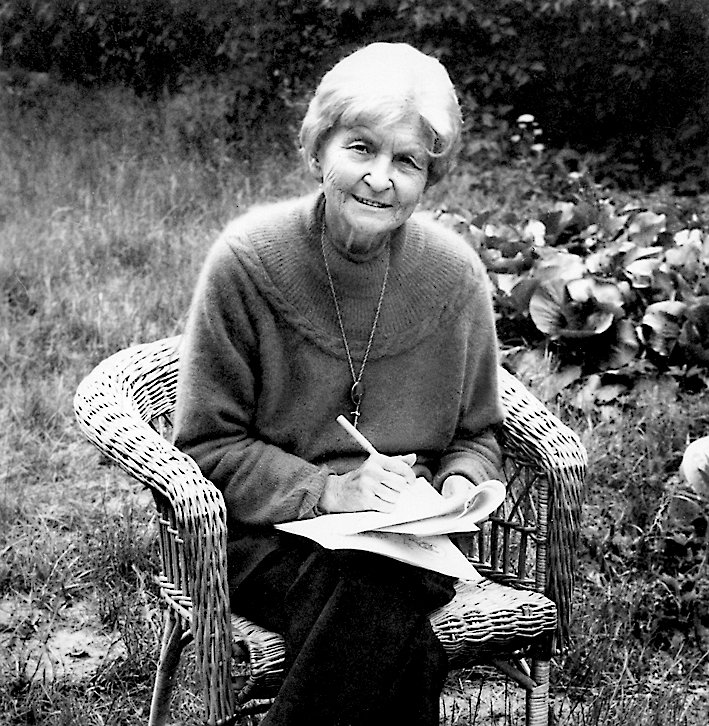
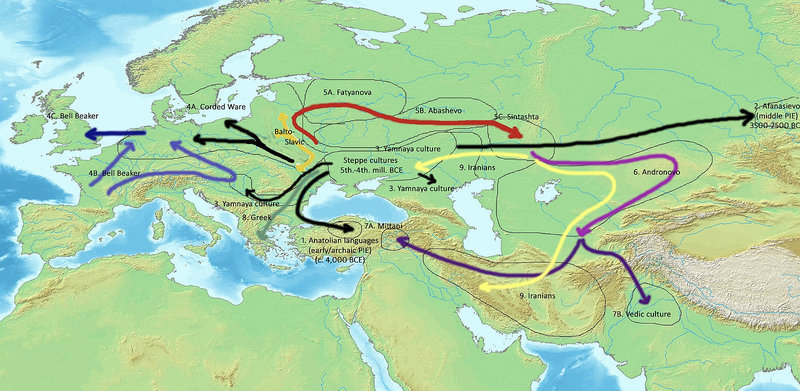
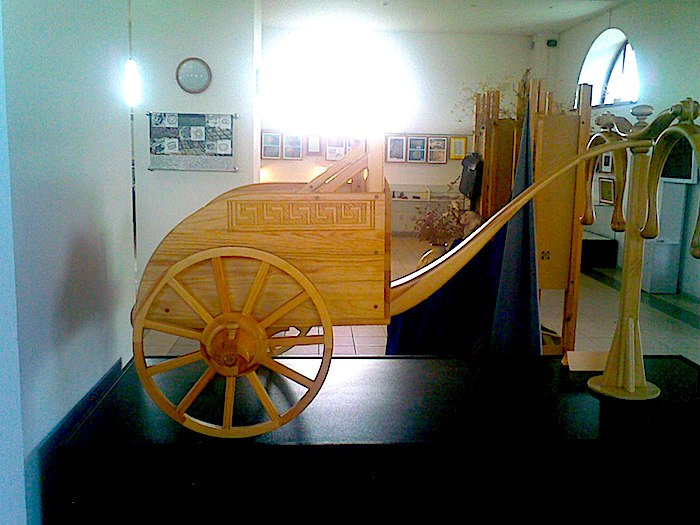

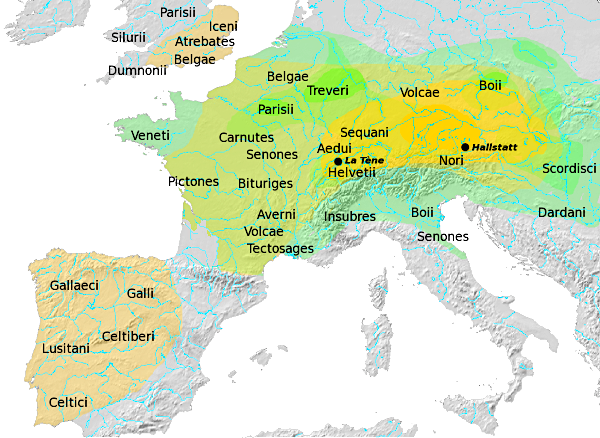



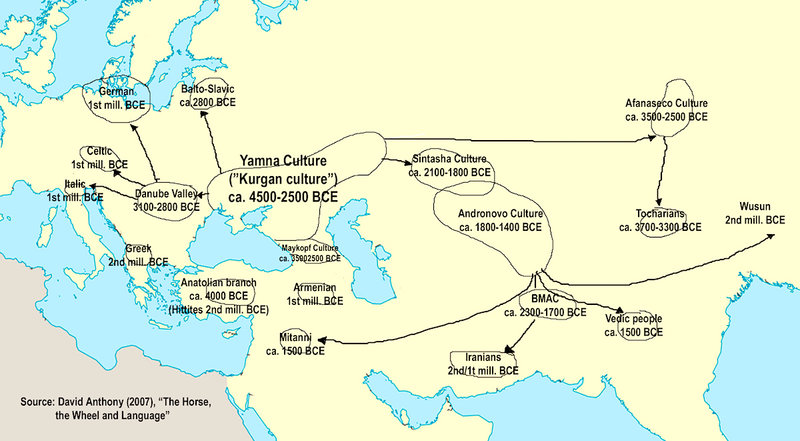

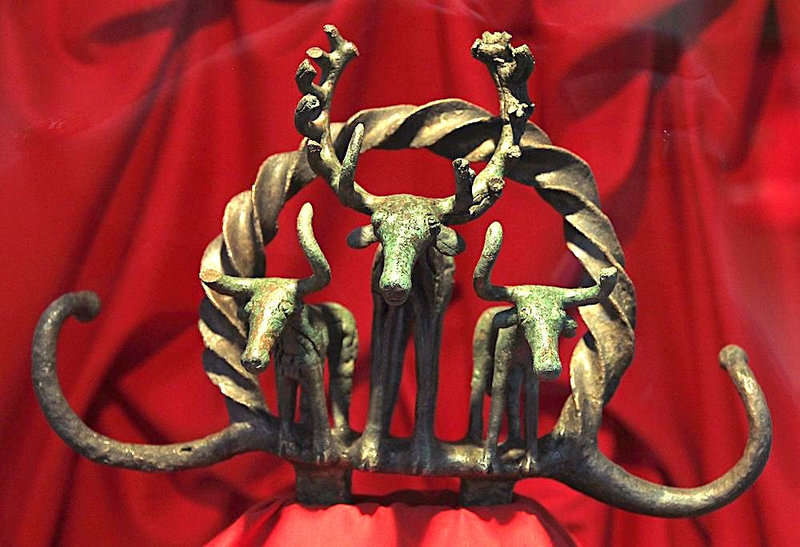
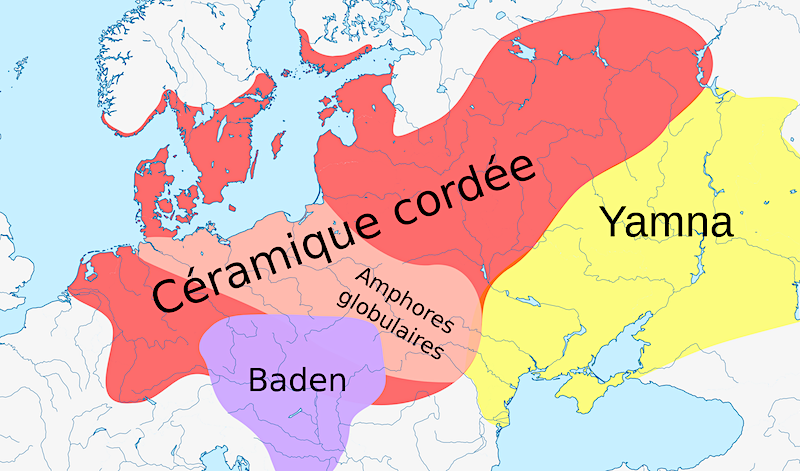
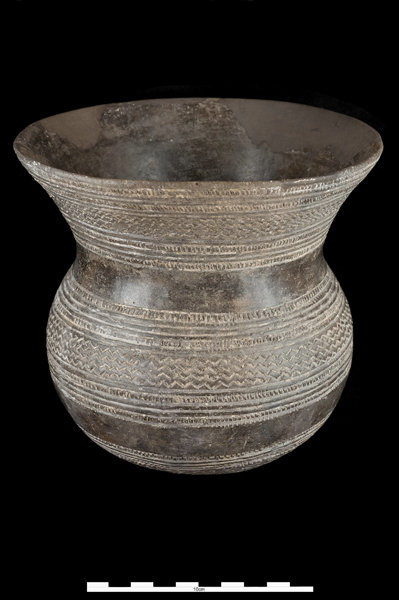
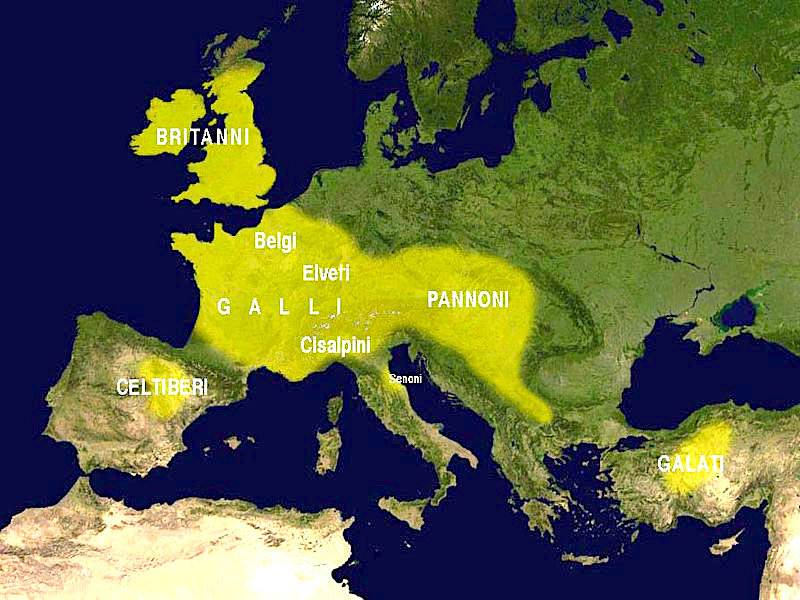


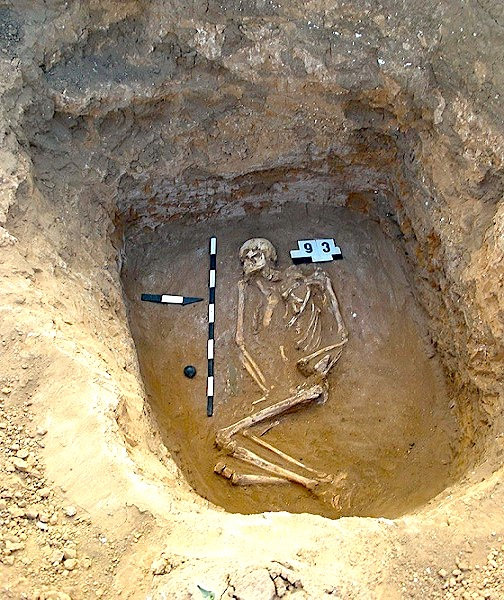

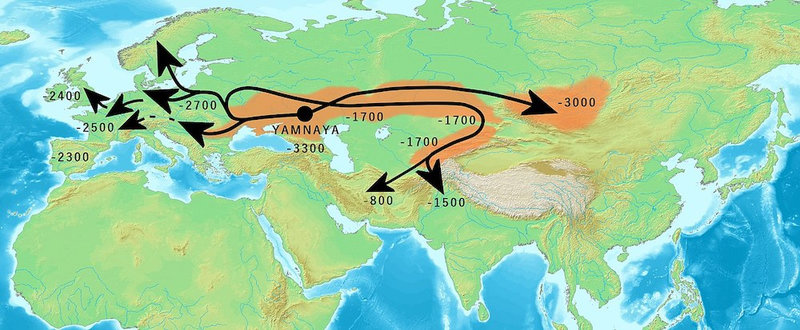
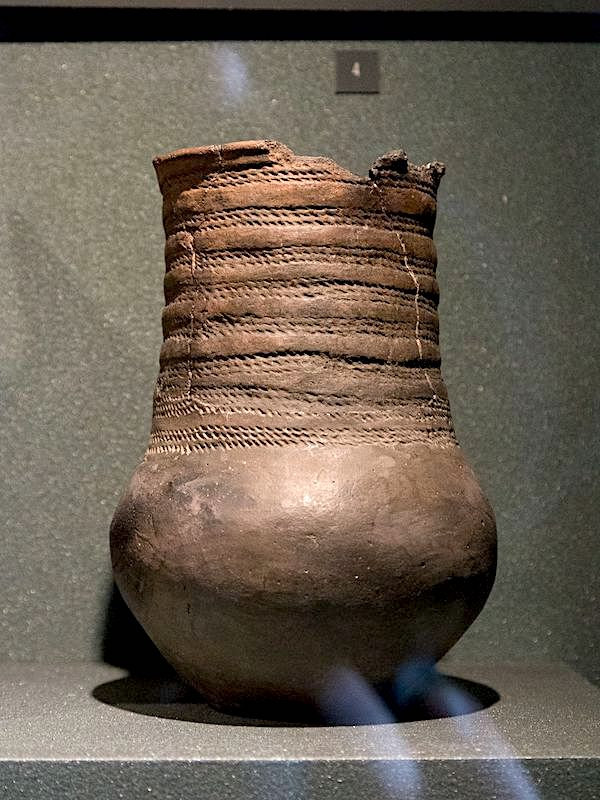

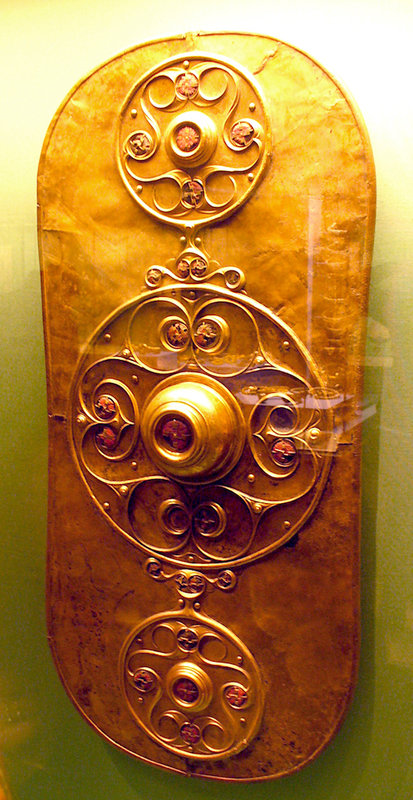
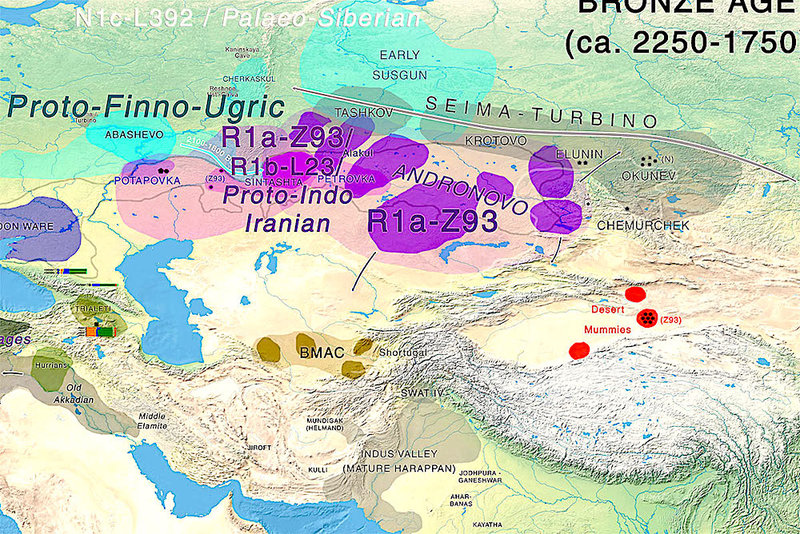


/http%3A%2F%2Fstorage.canalblog.com%2F42%2F21%2F321345%2F133835185_o.jpeg)
/http%3A%2F%2Fstorage.canalblog.com%2F60%2F50%2F321345%2F131836320_o.jpg)
/http%3A%2F%2Fstorage.canalblog.com%2F73%2F77%2F321345%2F130540623_o.jpg)
/http%3A%2F%2Fstorage.canalblog.com%2F07%2F27%2F321345%2F126713582_o.jpg)